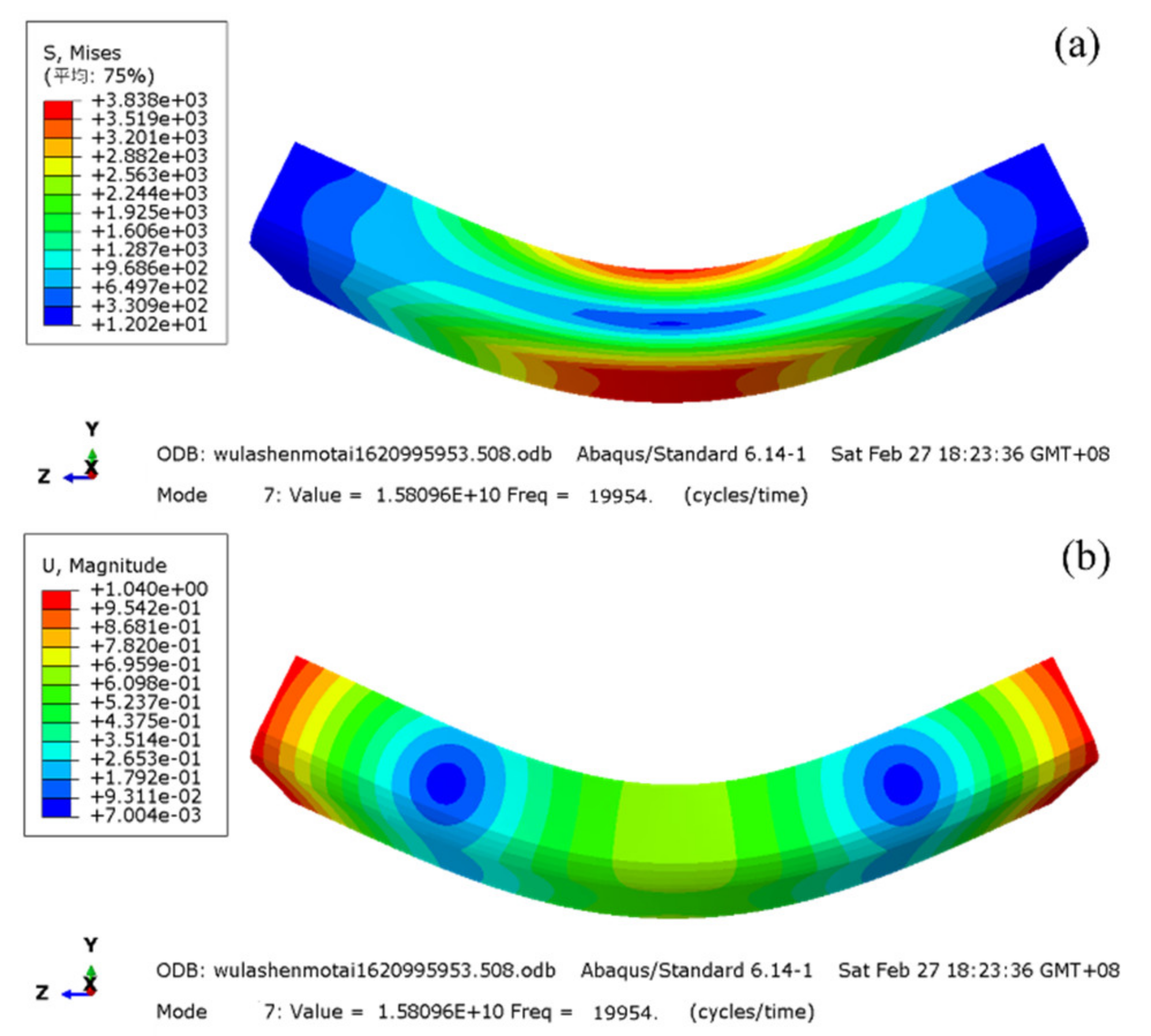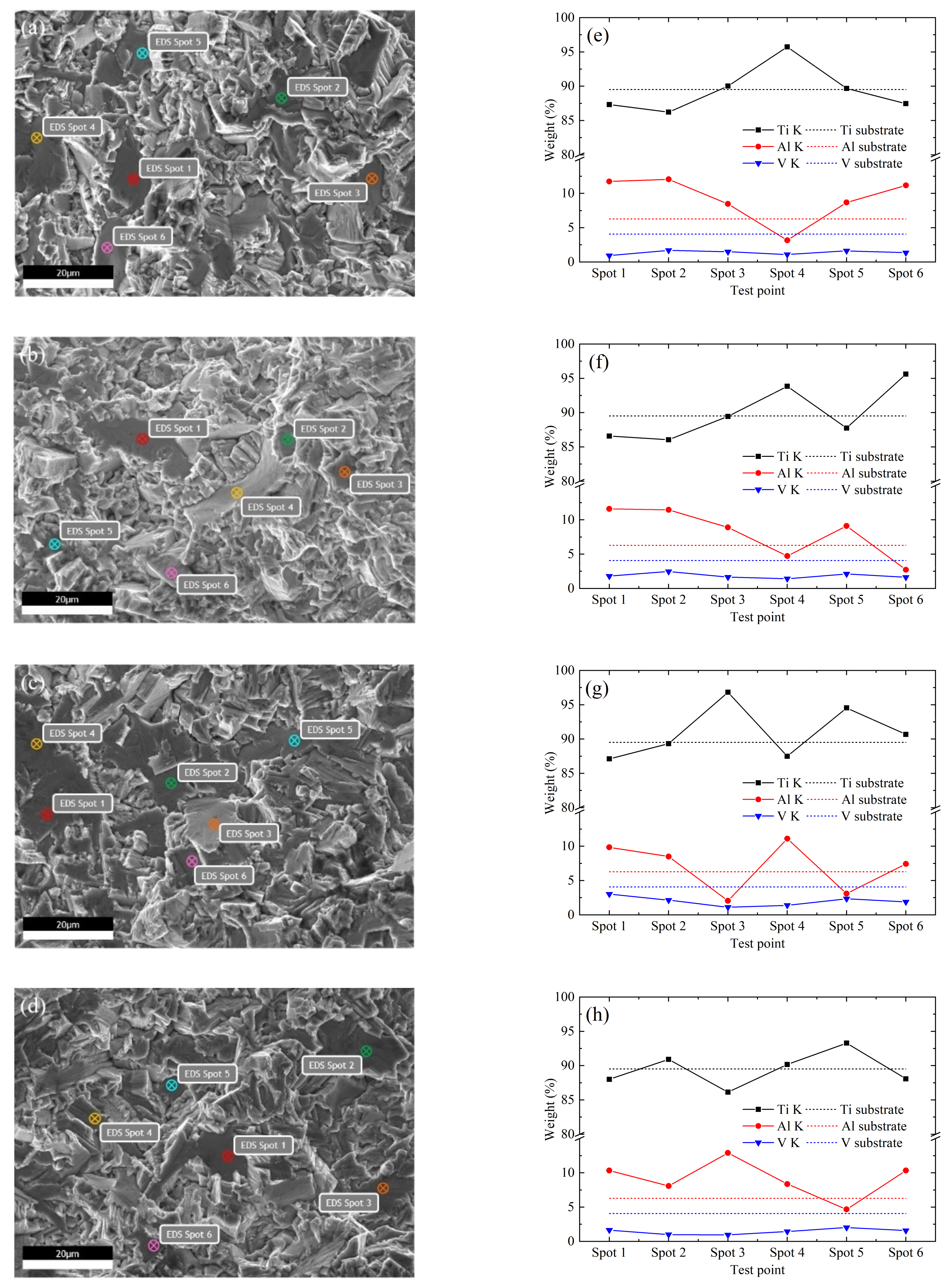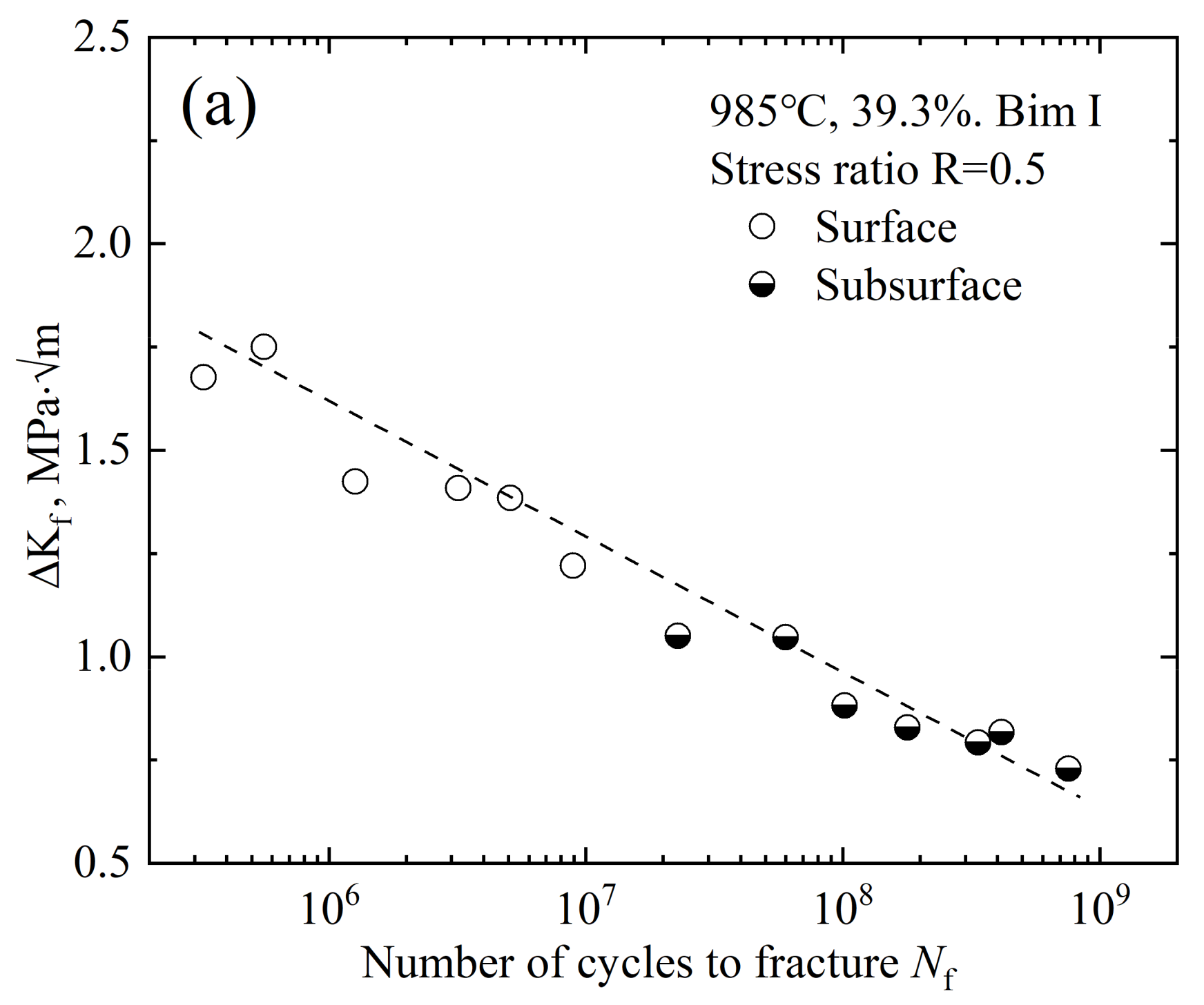Experimental Study on Forged TC4 Titanium Alloy Fatigue Properties under Three-Point Bending and Life Prediction
Abstract
:1. Introduction
2. Materials and Methods
2.1. Materials
2.2. Methods
3. Results
3.1. S-N Curves
3.2. Fatigue Fracture Morphology
4. Discussion
4.1. Analysis of Crack Initiation Mechanism
4.2. Analysis of Microstructure Influence
4.3. Fatigue Life Prediction Based on Energy
5. Conclusions
- As the number of loading cycles increases, the crack initiation changes from surface to subsurface initiation. The S-N curves have different shapes, and there is no traditional fatigue limit. The equiaxed high-cycle-fatigue performance is better, while the bimodal ultra-high-cycle-fatigue performance is better. The best forging process combination is 985 °C with a 39.3% deformation degree.
- The crack origin zones in the four kinds of microstructures show the mixed morphology of facets, cleavage steps, and MPT characteristics. The crack originates from the surface or subsurface facet, showing a transgranular quasi-cleavage fracture mechanism. The ultra-high-cycle-fatigue striation spacing is smaller than that of high-cycle-fatigue for the same microstructure, which reflects a higher crack propagation life.
- The facet in the crack origin zone is formed by the cleavage of primary α grains. Most of these primary α grains are attributed to the Al element-promoting effect, while a few of them hardly need the Al element assistance. The fatigue cracks originate from the preferred texture of primary α grains, rather than the primary α grain clusters.
- High-cycle-fatigue belongs to macro-scale fatigue, the fatigue failure is mainly controlled by surface stress, and the influence of the microstructure is small. While ultra-high-cycle-fatigue belongs to micro-scale fatigue, the fatigue failure is controlled by both surface stress and internal defects, and the influence of the microstructure is great. This makes the equiaxed and bimodal microstructure have better high-cycle-fatigue and ultra-high-cycle-fatigue performance, respectively.
- The stress intensity factor amplitude ΔKFC of faceted clusters can be analogized to the threshold ΔKth to control the macroscopic stable crack propagation, and the life prediction curve related to the faceted cluster size is basically consistent with the fatigue data, which shows that it is reasonable to apply the axial tension–compression fatigue analysis model to three-point bending fatigue, which is attributed to the similar fatigue failure mechanism.
Author Contributions
Funding
Conflicts of Interest
References
- Zimmermann, M. Diversity of damage evolution during cyclic loading at very high numbers of cycles. Int. Mater. Rev. 2012, 57, 73–91. [Google Scholar] [CrossRef]
- Mayer, H. Recent developments in ultrasonic fatigue. Fatigue Fract. Eng. Mater. Struct. 2016, 39, 3–29. [Google Scholar] [CrossRef]
- Oguma, H.; Nakamura, T. Formation mechanism of specific fracture surface region in the sub-surface fracture of titanium alloy. Adv. Mater. Res. 2014, 891–892, 1436–1441. [Google Scholar] [CrossRef]
- Günther, J.; Krewerth, D.; Lippmann, T.; Leuders, S.; Tröster, T.; Weidner, A.; Biermann, H.; Niendorf, T. Fatigue life of additively manufactured Ti-6Al-4V in the very high cycle fatigue regime. Int. J. Fatigue 2017, 94, 236–245. [Google Scholar] [CrossRef]
- Uematsu, Y.; Kakiuchi, T.; Hattori, K. EBSD assisted fractography of subsurface fatigue crack initiation mechanism in the ultrasonic shot peened βeta-type titanium alloy. Fatigue Fract. Eng. Mater. Struct. 2018, 41, 2239–2248. [Google Scholar] [CrossRef]
- Furuya, Y.; Nishikawa, H.; Hirukawa, H.; Nagashima, N.; Takeuchi, E. Catalogue of NIMS fatigue data sheets. Sci. Technol. Adv. Mater. 2019, 20, 1055–1072. [Google Scholar] [CrossRef] [PubMed] [Green Version]
- Hong, Y.; Sun, C.; Liu, X. A review on mechanisms and models for very-high-cycle fatigue of metallic materials. Adv. Mech. 2018, 48, 1–65. [Google Scholar]
- Sakai, T.; Nakagawa, A.; Oguma, N.; Nakamura, Y.; Ueno, A.; Kikuchi, S.; Sakaida, A. A review on fatigue fracture modes of structural metallic materials in very high cycle regime. Int. J. Fatigue 2016, 93, 339–351. [Google Scholar] [CrossRef]
- Bao, X.; Cheng, L.; Ding, J.; Chen, X.; Lu, K.; Cui, W. The effect of microstructure and axial tension on three-point bending fatigue behavior of TC4 in high cycle and very high cycle regimes. Materials 2020, 13, 68. [Google Scholar] [CrossRef] [Green Version]
- Yang, K.; Zhong, B.; Huang, Q.; He, C.; Huang, Z.Y.; Wang, Q.; Liu, Y.J. Stress Ratio and Notch Effects on the Very High Cycle Fatigue Properties of a Near-Alpha Titanium Alloy. Materials 2018, 11, 1778. [Google Scholar] [CrossRef] [Green Version]
- Hong, Y.; Lei, Z.; Sun, C. Propensities of crack interior initiation and early growth for very-high-cycle fatigue of high strength steels. Int. J. Fatigue 2014, 58, 144–151. [Google Scholar] [CrossRef] [Green Version]
- Pan, X.; Hong, Y. High-cycle and very-high-cycle fatigue behaviour of a titanium alloy with equiaxed microstructure under different mean stresses. Fatigue Fract. Eng. Mater. Struct. 2019, 42, 1950–1964. [Google Scholar] [CrossRef]
- Oguma, H.; Nakamura, T. The effect of microstructure on very high cycle fatigue properties in Ti-6Al-4V. Scr. Mater. 2010, 63, 32–34. [Google Scholar] [CrossRef] [Green Version]
- Jha, S.K.; Szczepanski, C.J.; Golden, P.J.; Porter, I.I.I.W.J.; John, R. Characterization of fatigue crack-initiation facets in relation to lifetime variability in Ti-6Al-4V. Int. J. Fatigue 2012, 42, 248–257. [Google Scholar] [CrossRef]
- Liu, X.; Chen, E.; Zeng, F. Mechanisms of interior crack initiation in very-high-cycle fatigue of high-strength alloys. Eng. Fract. Mech. 2019, 212, 153–163. [Google Scholar] [CrossRef]
- Liu, X.; Sun, C.; Hong, Y. Faceted crack initiation characteristics for high-cycle and very-high-cycle fatigue of a titanium alloy under different stress ratios. Int. J. Fatigue 2016, 92, 434–441. [Google Scholar] [CrossRef] [Green Version]
- Wu, Y.; Liu, J.; Wang, H.; Guan, S.; Yang, R.; Xiang, H. Effect of stress ratio on very high cycle fatigue properties of Ti-10V-2Fe-3Al alloy with duplex microstructure. J. Mater. Sci. Technol. 2018, 34, 1189–1195. [Google Scholar] [CrossRef]
- Huang, Z.Y.; Liu, H.Q.; Wang, H.M.; Wagner, D.; Khan, M.K.; Wang, Q.Y. Effect of stress ratio on VHCF behavior for a compressor blade titanium alloy. Int. J. Fatigue 2016, 93, 232–237. [Google Scholar] [CrossRef]
- Yang, K.; He, C.; Huang, Q.; Huang, Z.Y.; Wang, C.; Wang, Q.; Liu, Y.J.; Zhong, B. Very high cycle fatigue behaviors of a turbine engine blade alloy at various stress ratios. Int. J. Fatigue 2017, 99, 35–43. [Google Scholar] [CrossRef]
- Furuya, Y.; Takeuchi, E. Gigacycle fatigue properties of Ti-6Al-4V alloy under tensile mean stress. Mater. Sci. Eng. A 2014, 598, 135–140. [Google Scholar] [CrossRef]
- Nie, B.; Zhao, Z.; Chen, D. Effect of basketweave microstructure on very high cycle fatigue behavior of TC21 titanium alloy. Metals 2018, 8, 401. [Google Scholar] [CrossRef] [Green Version]
- Li, W.; Li, M.; Sun, R.; Xing, X.; Wang, P.; Sakai, T. Faceted crack induced failure behavior and micro-crack growth based strength evaluation of titanium alloys under very high cycle fatigue. Int. J. Fatigue 2020, 131, 105369. [Google Scholar] [CrossRef]
- Deng, R.; Yang, G.; Mao, X.; Zhang, P.; Han, D. Effects of Forging Process and Following Heat Treatment on Microstructure and Mechanical Properties of TC11 Titanium Alloy. Mater. Mech. Eng. 2011, 35, 58–62. [Google Scholar]
- Pan, Q.; Yu, X.; Qi, Y.; Huang, Q.; Pan, G. Effect of Thermal Tensile Deformation and Solution Aging Treatment on Microstructure of TC4-DT Titanium Alloy. Mater. Mech. Eng. 2019, 43, 21–26. [Google Scholar]
- Tanaka, S.; Akahori, T.; Niinomi, M.; Nakai, M. Relationship between Microstructure and Fatigue Properties of Forged Ti-5Al-2Sn-2Zr-4Mo-4Cr for Aircraft Applications: Engineering Materials and Their Applications. Mater. Trans. 2020, 61, 2017–2024. [Google Scholar] [CrossRef]
- Nikitin, A.; Bathias, C.; Palin-Luc, T. A new piezoelectric fatigue testing machine in pure torsion for ultrasonic gigacycle fatigue tests: Application to forged and extruded titanium alloys. Fatigue Fract. Eng. Mater. Struct. 2015, 38, 1294–1304. [Google Scholar] [CrossRef] [Green Version]
- Nikitin, A.; Palin-Luc, T.; Shanyavskiy, A. Crack initiation in VHCF regime on forged titanium alloy under tensile and torsion loading modes. Int. J. Fatigue 2016, 93, 318–325. [Google Scholar] [CrossRef] [Green Version]
- Sinha, V.; Pilchak, A.L.; Jha, S.K.; Porter, W.J.; John, R.; Larsen, J.M. Correlating Scatter in Fatigue Life with Fracture Mechanisms in Forged Ti-6242Si Alloy. Metall. Mater. Trans. A 2018, 49, 1061–1078. [Google Scholar] [CrossRef]
- Chandran, K.S.R. Duality of fatigue failures of materials caused by Poisson defect statistics of competing failure modes. Nat. Mater. 2005, 4, 303–308. [Google Scholar] [CrossRef]
- Yang, K.; Zhong, B.; Huang, Q.; He, C.; Huang, Z.Y.; Wang, Q.; Liu, Y.J. Stress ratio effect on notched fatigue behavior of a Ti-8Al-1Mo-1V alloy in the very high cycle fatigue regime. Int. J. Fatigue 2018, 116, 80–89. [Google Scholar] [CrossRef]
- JZuo, H.; Wang, Z.G.; Han, E.H. Effect of microstructure on ultra-high cycle fatigue behavior of Ti-6Al-4V. Mater. Sci. Eng. A 2007, 473, 147–152. [Google Scholar]
- Stanzl-Tschegg, S.; Mughrabi, H.; Schoenbauer, B. Life time and cyclic slip of copper in the VHCF regime. Int. J. Fatigue 2007, 29, 2050–2059. [Google Scholar] [CrossRef]
- Chai, G.; Zhou, N.; Ciurea, S.; Andersson, M.; Peng, R.L. Local plasticity exhaustion in a very high cycle fatigue regime. Scr. Mater. 2012, 66, 769–772. [Google Scholar] [CrossRef]
- Murakami, Y.; Kodama, S.; Konuma, S. Quantitative evaluation of effects of non-metallic inclusions on fatigue strength of high strength steels. I: Basic fatigue mechanism and evaluation of correlation between the fatigue fracture stress and the size and location of non-metallic inclusions. Int. J. Fatigue 1989, 11, 291–298. [Google Scholar] [CrossRef]
- Li, W.; Xing, X.; Gao, N.; Wang, P. Subsurface crack nucleation and growth behavior and energy-based life prediction of a titanium alloy in high-cycle and very-high-cycle regime. Eng. Fract. Mech. 2019, 221, 106705. [Google Scholar] [CrossRef]

















| Al | V | Fe | O | C | H | N | Ti |
|---|---|---|---|---|---|---|---|
| 6.27 | 4.08 | 0.048 | 0.021 | 0.020 | 0.004 | 0.031 | Bal. |
| Forging Process | Forging Type | Content (%) | Grain Size (μm) | Standard Deviation (μm) | Microstructure |
|---|---|---|---|---|---|
| 950 °C/39.3% | α + β | 45.24 | 42.54 | 13.75 | equiaxed I |
| 950 °C/69.6% | α + β | 48.74 | 34.68 | 16.80 | equiaxed II |
| 985 °C/39.3% | near β | 27.54 | 23.62 | 19.92 | bimodal I |
| 985 °C/69.6% | near β | 23.78 | 24.68 | 10.43 | bimodal II |
| Microstructure | σR/MPa | σ0.2/MPa | A/% | Z/% | E/GPa | v |
|---|---|---|---|---|---|---|
| equiaxed I | 967 | 898 | 16.2 | 46.8 | 115.85 | 0.317 |
| equiaxed II | 1003 | 951 | 15.8 | 47.6 | 116.83 | 0.329 |
| bimodal I | 986 | 907 | 14.2 | 51.1 | 120.29 | 0.332 |
| bimodal II | 998 | 924 | 15.2 | 49.5 | 118.91 | 0.324 |
Publisher’s Note: MDPI stays neutral with regard to jurisdictional claims in published maps and institutional affiliations. |
© 2021 by the authors. Licensee MDPI, Basel, Switzerland. This article is an open access article distributed under the terms and conditions of the Creative Commons Attribution (CC BY) license (https://creativecommons.org/licenses/by/4.0/).
Share and Cite
Wang, B.; Cheng, L.; Li, D. Experimental Study on Forged TC4 Titanium Alloy Fatigue Properties under Three-Point Bending and Life Prediction. Materials 2021, 14, 5329. https://doi.org/10.3390/ma14185329
Wang B, Cheng L, Li D. Experimental Study on Forged TC4 Titanium Alloy Fatigue Properties under Three-Point Bending and Life Prediction. Materials. 2021; 14(18):5329. https://doi.org/10.3390/ma14185329
Chicago/Turabian StyleWang, Bohan, Li Cheng, and Dongchun Li. 2021. "Experimental Study on Forged TC4 Titanium Alloy Fatigue Properties under Three-Point Bending and Life Prediction" Materials 14, no. 18: 5329. https://doi.org/10.3390/ma14185329






